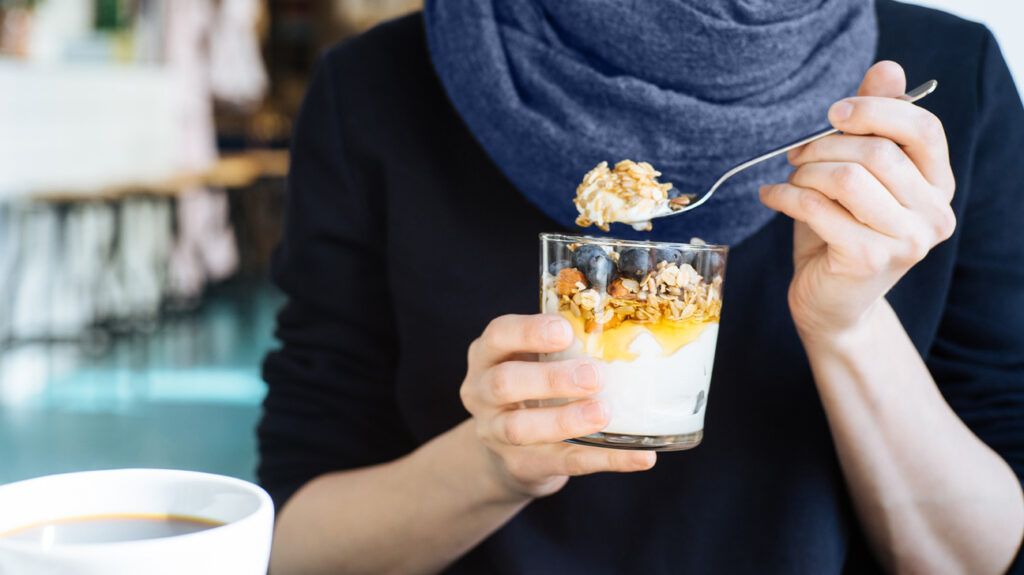Antibiotics can cause side effects, such as abdominal pain and loss of appetite. Eating certain foods may help prevent these types of side effects.
Antibiotics are medications that fight bacteria. They work either by killing bacteria or by stopping it from reproducing.
These drugs often cause gastrointestinal side effects, such as:
- nausea
- diarrhea
- bloating
- indigestion
- abdominal pain
- loss of appetite
These side effects may be uncomfortable, but they tend to pass quickly.
Eating the right foods can help to prevent side effects and encourage healing.

A person’s gut contains trillions of bacteria and other microorganisms, which the medical community refers to as the gut microbiome.
Antibiotics fight bacteria, and they can upset the balance of bacteria in the microbiome.
The gut microbiome keeps the digestive system functioning and helps the immune system defend against viral infection.
When antibiotics upset the bacterial balance, a person may experience side effects, such as nausea or diarrhea.
An effective way to restore the balance of gut bacteria is to eat a variety of minimally processed whole foods that contain the natural micronutrients the gut needs to thrive.
Doctors may recommend taking probiotic supplements for specific clinical conditions or to prevent antibiotic associated diarrhea. However, in some cases, the limited numbers of bacteria in probiotic products can colonize and dominate the gut. A doctor will make recommendations based on an individual’s situation and goal.
Foods containing fiber, probiotics, and vitamin K may help restore the balance of bacteria in the gut, as the following sections explain:
Fiber
Many plant foods contain prebiotic fibers, which can feed the beneficial bacteria in the gut microbiome. This may help restore balance in the gut after taking antibiotics.
Prebiotic foods include:
- fruits
- vegetables
- legumes
- whole grains
- nuts
- seeds
Plant foods also contain vitamins, minerals, and other nutrients that provide various health benefits.
Manufacturers also add prebiotic ingredients to some processed foods, such as cereals and breads, although these may not have as many health benefits as whole foods close to their naturally-grown state.
Examples of prebiotic foods include:
- nuts, such as almonds, cashews, and hazelnuts
- bananas
- cabbage
- artichokes
- peas
- onion
- garlic
- jicama
- leafy green vegetables
- asparagus
- beans
- whole grains, such as rye, oats, and barley
Fermented foods
Fermented foods are good sources of beneficial bacteria. All fermented foods contain microorganisms, but some heat or filtration processes can kill the beneficial bacteria.
Fermented vegetables, such as sauerkraut or pickles in jars and stored at room temperature, do not contain live cultures.
Microorganisms do not survive baking processes, so they are not present in foods such as sourdough bread, although some of their beneficial byproducts are.
Foods that contain these organisms often have “live and active cultures” on their labels. Fermented foods include:
Vitamin K
Antibiotics fight all kinds of bacteria, even those that help the body. Antibiotics
To reduce the impact of antibiotics on vitamin K levels, people can eat:
- kale
- spinach
- turnip greens
- collards
- Swiss chard
- parsley
- mustard greens
- Brussels sprouts
Some foods prevent the body from absorbing antibiotics, so the medication is less effective than it should be. They include:
grapefruitsTrusted Source and grapefruit juice- dairy products
- alcohol
- fruit juices
- supplements containing calcium
After taking an antibiotic, a person should wait for
It is sensible to avoid alcohol while taking any medication. In most cases, moderate drinking will not interfere with antibiotics, but it may worsen the side effects.
A doctor will advise a person not to drink any alcohol if they are taking one of the following antibiotics:
- Metronidazole: This can treat gastrointestinal tract infections, dental infections, vaginal infections, infected leg ulcers, and pressure sores.
- Tinidazole: This also treats dental infections, vaginal infections, infected leg ulcers, and pressure sores and clears bacteria called Helicobacter pylori from the gut.
Drinking alcohol while on one of these antibiotics can cause a serious reaction and the following symptoms:
- nausea
- abdominal pain
- hot flashes
- a fast or irregular heartbeat
- headaches
- dizziness
- drowsiness
People should avoid alcohol for a further 48 hours after finishing a course of metronidazole and for 72 hours after finishing a course of tinidazole.
It is vital to restore a healthy balance in the gut microbiome after taking a course of antibiotics. People can do this by eating a variety of whole foods containing probiotics, prebiotics, vitamins and minerals. These include fruits and vegetables, fermented foods, nuts and seeds, beans, and whole grains.
Some foods can interact with antibiotics, making them less effective. These include grapefruit and foods fortified with high doses of calcium, such as some orange juices.




